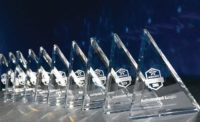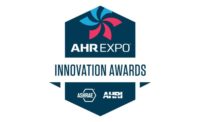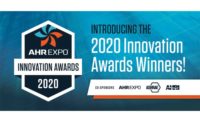This year, Engineered Systems asked some of the winners of the award about innovation, and what they believe is the next step in engineering ingenuity for the HVACR industry. Here is what a few of those manufacturers had to say.
Article Index:
- And the winner is...
- A Sustainable Future
- Health and IAQ
- Tools In The Field
- 2018 AHR Expo Innovation Award Winners
And the winner is…
At the 2018 AHR Expo in Chicago, Danfoss was the winner in the green building category, and honored with the top innovative product of the year for its Turbocor TTH/TCH Lift Compressor. According to Danfoss, the compressors are the first oil-free, variable speed, magnetic bearing centrifugal compressors that can operate at a wide range of high lift applications, including air-cooled chillers in hot ambient climates, heat recovery, heat pump, ice storage, and low temperature process.
Jose Alvares, vice president of sales and marketing for Danfoss Turbocor Compressors, explained that positive displacement compressors such as scroll and screw type have been the commonly used compressor in these types of applications due to their large operating map. However, with the new high lift operating map offered by the Turbocor TTH/TGH compressors, chiller manufacturers now have the option to use oil-free, magnetic bearing centrifugal compressor technology which offers up to a 25% efficiency improvement. Also, he says the company is the first centrifugal compressor manufacturer to offer both R-513A and HFO-1234ze low-GWP refrigerants for use in this type of high lift application. This ensures that customers are prepared to meet current and future refrigerant regulations.
But what about the future? According to Jonathan Holloway, North American strategic marketing director for Danfoss, it is all about smart, connected products that will further ensure improved and sustained efficiencies.
“We have moved from imagining the endless potential of the IoT to gathering and using data to deliver performance,” he said. “Just within the Danfoss portfolio, you can gather 250 data points from a compressor in a chiller, aggregate this with input from VFDs and even valve actuators, to not only sense and track but calculate and optimize how components are working together in a system. Combining best practices in green design with data and analytics is powerful in achieving and sustaining high efficiency.”
When it comes to the adoption of green building, Holloway says that building information modeling will lead the way for two reasons. First, he says BIM technology is improving, so it is now easier to apply a systems approach.
“Architects and engineers can consider interdependencies in a system, like pump and hydronic control methods, and implement synergistic best practices,” said Holloway.
Second, BIM adoption and coordination are on the rise, so consultants, contractors, suppliers, and owners can all understand and work toward common goals in a more transparent way.
A Sustainable Future
Emerson was also recognized for its compressors. The company was honored in the cooling category for its Copeland Scroll two-stage compressor. Emerson officials said the two-stage capacity design of the compressor provides more precise control for commercial and residential applications. It also helps to maintain humidity levels and offer greater energy efficiency than single-stage compressors.
The Copeland Scroll two-stage now features an add-on modulation control that will enable partial system replacements for residential systems. David Hules, director of marketing for commercial air conditioning at Emerson, said this allows owners to upgrade their system without an entire heating and cooling system replacement. He also said the commercial sizes now enable equipment OEMs to achieve new rooftop efficiency minimums “at an excellent applied cost.”
Hules also said that Emerson will continue to see the growth of capacity modulation technologies for both residential and commercial applications. For example, this includes two-stage, digital, variable speed, and multiple manifolded compressors.
“Our industry’s ability to apply the right modulation technologies for the right applications will continue to deliver higher efficiency equipment along with the comfort benefits that come with modulated technologies,” said Hules.
In addition to efficiency, Emerson is also looking at the reduction of higher global warming potential refrigerants.
“We are in the process of researching and developing next-generation products to support the industry’s need for solutions that are optimized for low-GWP refrigerants,” said Hules. “This is being done in close cooperation with the refrigerant manufacturers as well as our OEM customers.”
And speaking of low-GWP refrigerants, Chemours was an Innovation Award winner for its Opteon Xp44 Refrigerant (R-452A). The refrigerant is a non-ozone depleting, low-GWP, HFO-based refrigerant replacement for R-404A/507. Company officials said the refrigerant offers an approximate 50% reduction in global warming potential when compared to R-440A/R-507, while also serving as a close match to the compressor discharge temperature of other low-GWP refrigerants on the market.
Health and IAQ
According to the CDC, there were 6,000 cases of Legionnaires’ disease reported in 2015. Also, the CDC reports that one in every 10 people who contract the disease will die. Spartan Bioscience is trying to reverse these trends with its Spartan Legionella Detection System, which was an Innovation Award winner in the indoor air quality category.
“The Spartan Legionella Detection System is the world’s first on-site Legionella DNA test. It is a groundbreaking new tool to help prevent Legionnaires’ disease outbreaks,” said Paul Lem, MD, CEO and founder of Spartan Bioscience. “It quantifies the amount of live Legionella bacteria in a water sample in 45 minutes. For the first time, building managers can get Legionella results on demand.”
Lem explained that many property managers monitor their water systems for Legionella with monthly culture tests, but this testing can be inaccurate. In addition, Legionella can reach outbreak levels of 1,000 colony forming units (CFU) per milliliter in as few as seven days and culture testing takes 14 days to yield results. The Spartan Detection System helps to solve the accuracy problem with weekly testing before water sources reach outbreak levels.
Lem said Spartan’s vision “is to eradicate Legionnaires’ disease.” This means going forward, building owners need to continue to be proactive wherever Legionella can occur.
“Globally, there are millions of cooling towers, domestic hot water systems, fountains, hot tubs, and humidifiers that are at risk for Legionella contamination,” said Lem. “The Spartan Legionella Detection System is the first practical way to monitor and prevent outbreaks in these water systems.”
Triatek is also hoping to keep individuals safe and healthy with its Stable Vortex II Fume Hood, which was the winner in the ventilation category. The fume hood was recognized because it actively senses and measures the airflow within the hood, and adjusts in real time to dynamic environmental changes such as cross drafts, user movement, and thermal changes in order to better protect the user and prevent the backflow of fumes into the user’s breathing zone.
Jim Hall, CEO of Triatek, explained that the design of the fume hood means that it can effectively contain with a face velocity of only 50 to 60 ft per minute.
“The technology behind the Stable Vortex® II is steering the industry to think about fume hood safety in a different way,” Hall explained. “It can effectively contain — and therefore protect the user — with a face velocity of 50 to 60 ft per minute, whereas 80 to 100 fpm is the longstanding industry norm that most people associate with a safe fume hood. However, the recent publication of the ASHRAE 110-2016 testing standard speaks to the evidence that higher speeds of airflow doesn’t necessarily equate to safety; airflow control and containment does.”
As for the next step in ventilation and IAQ, Hall says, “we see the future of HVACR moving towards utilizing more system data to inform on performance and to provide insights on how to enhance facility efficiency and product reliability.”
He also believes a holistic approach to HVACR system needs and providing customized solutions based on the way a facility is used will be the way of the future.
“No more ‘one-size-fits-all’ solutions,” he said. “Companies need to be able to offer clients a diverse array of products to fit their needs while providing cost savings and energy efficiency.”
Tools In The Field
In the category of tools and instruments, Fluke Corporation was the winner with its T6 Electric Tester. The instrument measures true RMS AC voltage without test leads. Officials said this saves time in the field, minimizes errors, and reduces the possibility of arc flash.
“Technicians have been familiar with Fluke’s popular open-fork T5 Electrical test for current measurements,” said Brian Painting, product manager for electrical testers at Fluke. “Now Fluke has added FieldSense technology to the open-fork concept to deliver a tester that measures — not just detects — both true RMS voltage and current simultaneously without making contact with a live electrical conductor.”
For the future, Fluke officials see test instruments that do more than just measure.
“From an overall market trend standpoint, there is a growing demand for tools which do more than simply provide measurements,” said Frederic Baudart, lead product application specialist for the Fluke Accelix. “Technicians need to share measurement data with others on the team and need access to real-time measurements.”
Baudart explained that this has created a need for “connected tools” and sensors that can communicate with each and with a central office.
“Data collected provides historical records for a complete picture of asset health. Fluke is addressing this category through its Fluke Accelix suite of solutions, which includes connected tools, sensors, and the integration of data, including data from third-party devices and systems,” said Baudart. “The acceleration change in reliability strategy is fueled by the needs of artificial intelligence and machine learning. The idea that a solution, which includes hardware and software, will provide us with not only the data but present actionable items to review and offer recommendations will be key to maintenance programs in the future.”
Regal is also aiming to make jobs easier in the field. The company was the Innovation Award winner in the software category for its Browning Toolbox Technician Motor Efficiency Calculator for Apple and Android devices. The app allows users to identify efficiency differences between different generations of integral horsepower electric motors.
“Motor efficiency rating tables have historically been available, but they lack the quantification of the impact of running a motor to fail or replacing proactively to save energy,” said Don Sullivan, director of marketing at Regal. “About 98% of the total cost of ownership in a motor’s lifetime will be the electrical energy it takes to operate it. That means only about 2% of all lifetime cost is the motor purchase. This app not only identifies the potential efficiency gain, but it allows the user to tailor the motor usage parameters to mirror their application or overall facility usage so a projected return on investment can be displayed.”
Motor efficiencies are an important topic, and that won’t be changing as time goes on.
According to Sullivan, the U.S. Department of Energy published that a 75-hp motor at 75% load running 6,000 hours a year at a rate of only $0.08 per kWh uses $21,900 annually in energy.
“Upgrading to a NEMA Premium Efficiency motor under the same operating conditions can result in an energy savings of 10,112 kWh and $809 per year, and payback for an upgrade to a NEMA premium motor can typically be gained in a two- to four-year window depending on the electricity rate being charged,” said Sullivan. “We see innovation continuing to move in the direction of energy efficiency and operational cost reductions and will continue to develop products that support our customers’ goals to be more efficient both in operational cost and energy while also providing the tools for our customers to analyze products and measure efficiencies.”
2018 AHR Expo Innovation Award Winners
| Building Automation | Winner: Setra Systems Inc.’s Setra Flex |
| Finalists: BELIMO Americas (6-way Electronic Pressure Independent Valve), Cielo WiGle Inc. (Breez: Smart Controller for Ductless Air-conditioning Systems), and Emerson (Site Supervisor facility control platform) | |
| Cooling | Winner: Emerson’s Copeland Scroll |
| Finalists: Delta Cooling Towers, Inc. (Delta Anti-Microbial Cooling Tower), Johnson Controls, Inc. (YORK® Affinity™ YXV 20 SEER Variable Capacity Air Conditioner), and ZIEHL-ABEGG, Inc. (ZAvblue centrifugal fan) | |
| Green Building | Winner: Danfoss Turbocor TTH/TVGH High Lift Compressor |
| Finalists: International Wastewater Systems Inc. (PIRANHA HC thermal energy recovery hot water production system), Nexus Valve, Inc. (Pressure Step Deaerator), Regal (NovaMAX™ Motor – 600 RPM), and Smardt Chiller Group Inc. (Smardt Solar Integrated Chiller (SSiC)) | |
| Heating | Winner: Calefactio’s The ONE |
| Finalists: Cleaver-Brooks, Inc. (Cleaver-Brooks ClearFire®-CE hydronic boiler), Johnson Controls, Inc. (YORK® Affinity™ YZV 20 SEER Variable Capacity Heat Pump), and WaterFurnace International, Inc. (Versatec Variable Speed water source/geothermal heat pump) | |
| Indoor Air Quality | Winner: Spartan Biosience Legionella Detection System |
| Finalists: AAF Flanders (Sensor360™ filtration monitor), Addison (Linear Capacity™, Dedicated Outdoor Air System), and Johnson Controls, Inc. (GLAS smart thermostat) | |
| Plumbing | Winner: Aquamotion Aqua-Flash |
| Finalists: Caleffi Hydronic Solutions (LEGIOMIX® electronic mixing valve with disinfection) and John Guest USA, Inc. (JG ProLock twist-to-lock fitting system) | |
| Refrigeration | Winner: Chemours Opteon XP44 Refrigerant |
| Finalists: CAREL INDUSTRIES S.p.A. (HEEZ control and management solution) and Emerson (Fractional horsepower low-temperature Copeland Scroll™ compressor) | |
| Software | Winner: Regal’s Browing Toolbox Technician Motor Efficiency Calculator |
| Finalists: Coolfront Technologies (Coolfront Mobile flat rate pricing app), LG Electronics USA, Inc. (LG Air Conditioning Technical Solution (LATS) Revit drawing plug-in), and SuperCool Slide Rule (SuperCool HVAC app) | |
| Tools and Instruments | Winner: Triatek Vortex II Fume Hood |
| Finalists: Regal (UlteMAX Axial PM Motor), Titus (TJD, OMNI diffuser), and ZIEHL-ABEGG, Inc. (ZAbluefin bionic, high-efficiency impeller) | |





